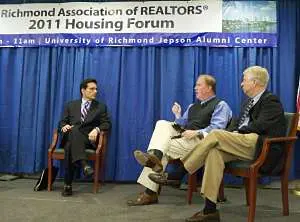In Part One, we discussed the impact of the Government Sponsored Enterprises of Fannie Mae, Freddie Mac and (less so) FHA.
- Part One – Mortgages and the GSE Guidelines
- Part Two (here) – The Role of the Fed
- Part Three – Congress, Taxes, Zoning and Building Codes
- Part Four – The Conclusion
In next installment, the topic of the Federal Reserve’s role will be discussed. While the complexity of the impact of the GSE’s is pretty hard to cover in a blog post, the impact of the Fed is even more so. For those purists who read this, understand that the purpose of the article is not to fully explain monetary policy but rather to take a look at some base level impacts of Fed decisions.
Part II, The Fed

While the Fed’s primary goal is to create a stable monetary environment whereby long term interest rates are predictable and employment is maximized, they have other powers as well…the most notable of which is the regulation of the banking institutions in the US. By having the ability to influence the demand for money as well as the availability of it, the Fed has an incalcuable impact on the housing market.
During the 2008-12 adjustment, the Fed simultaneously made money incredibly cheap and very easy. Partially for the reason of propping up failing banks (which would have been a catastrophe had they begun to fail en masse) and partially to spur economic activity, the Fed opened up its proverbial wallet and started tossing around cash like a drunk sailor on shore leave. While on the one hand they became the nation’s ATM, they also placed restrictions on loaning it out to the end user (for reasons I am not sure I understand.) A good friend of mine in banking told me, back in 2011, that careers in banking were made by NOT making loans, regardless of a deal’s merits. Despite interest rates at historic lows, banks were hamstrung from making loans by regulators from the very entity giving them free money to loan.
The Fed has the ability to not only influence money supply, but how and what it is loaned upon. Their regulatory power gives the Fed the ability to influence how much housing can be produced through policies designed to discourage speculative building. By restricting the production of new supply (which they have undeniably done), they are pushing pricing up…and that may not be the worst thing in the world. The question is whether or not they realize the correct levels at which to relax restrictions. As we stand here in late 2013, the rate of supply of new homes has returned to just over half of the pre-bubble level after production of new homes languished off 70% or more during the darkest days. By and large, we are still under-supplied.
While the need for the Fed is a real one, homeowners need to understand that the Fed’s mandate is not to protect your home’s value…it is to create long term stability in the interest rate markets and to maximize employment. Sometimes those goals are aligned, sometimes they are not and sometimes housing gets caught up in the wash.
Part Three Discusses Congress, Taxes and Building Codes










